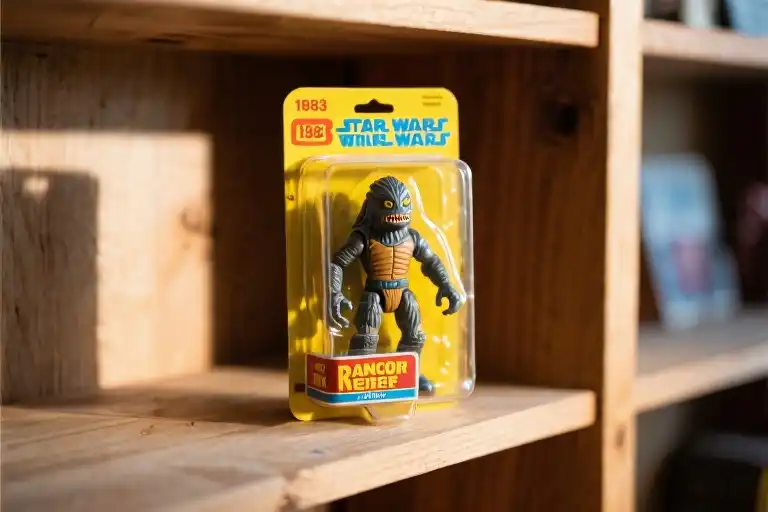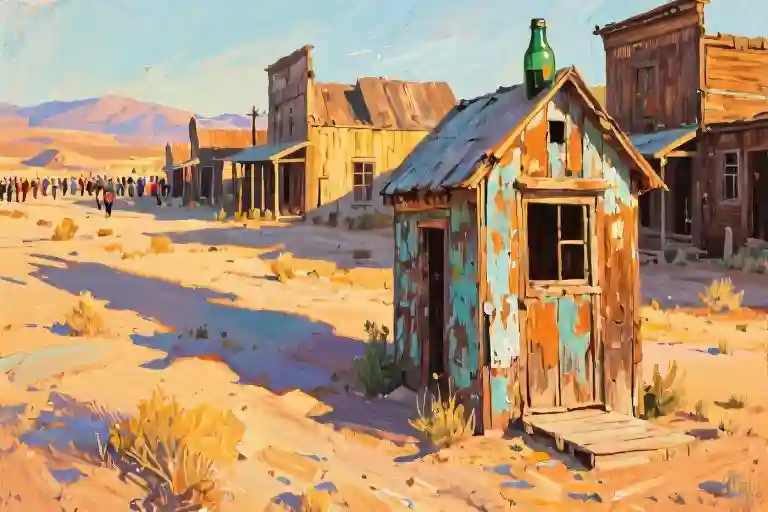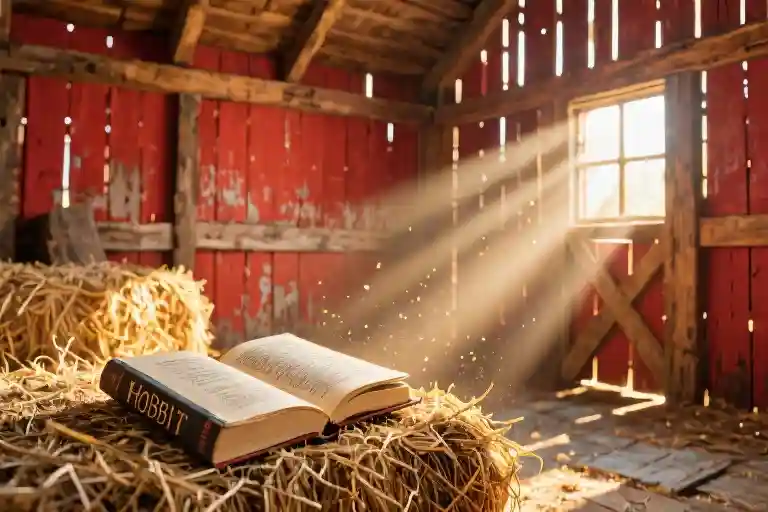The comment hit harder than a Wookiee’s slap. “You love these vintage Star Wars toys too much,” my cousin said last Thanksgiving, carefully avoiding eye contact with my display shelves. “Like there’s something missing from your heart, and you think old action figures will fill the void.”
Ouch.
And also, correct.
Take yesterday’s purchase: a mint-condition Rancor Keeper from 1983, still sealed in his yellowing plastic coffin. The price? Sixty-five American dollars. The original Kmart sticker clinging to the package tells a different story – $2.78, plus tax, back when Return of the Jedi was still in theaters. Some quick math:
$2.78 (original retail)
- 40 years of inflation
- one adult’s unresolved childhood longing
= $65 (apparently a bargain)
The plastic bubble has developed that distinctive nicotine-stain patina, making it look like the Rancor Keeper’s been holding his breath – or perhaps other bodily functions – since the Reagan administration. We’ve both changed since ’83. I’ve gained weight, lost hair, and developed questionable life choices. He’s remained perfectly preserved, floating in his amber of childhood wonder, though the plastic yellows like forgotten newspaper clippings.
There’s something poetic about how vintage toys age. The plastic doesn’t just discolor – it tells time. That particular shade of yellow doesn’t exist in Pantone books; it’s the color of Saturday morning cartoons watched through a haze of sugary cereal, of bike rides home from the local five-and-dime with a new figure clutched in sticky fingers. The yellowing isn’t decay – it’s the patina of memory.
My cousin wasn’t entirely wrong about the void. The toys aren’t filling it so much as mapping its contours. Each yellowed bubble, each cracked rubber band holding a lightsaber in place, each price tag from a defunct department store – they’re coordinates in a personal nostalgia constellation. The $65 isn’t for the plastic; it’s for the permission slip back to a time when the biggest problems could be solved by a well-aimed Millennium Falcon swooping across the living room carpet.
Collecting isn’t about the objects. It’s about the space between them – the negative shape of childhood that we spend adulthood trying to trace. The Rancor Keeper isn’t valuable because he’s rare (though he is), or because he’s well-preserved (despite the gaseous emissions suggested by his packaging). He’s valuable because when I hold that yellowed bubble, I’m not a 45-year-old accountant – I’m eight again, sprawled on shag carpet, making explosion noises with my mouth as Jabba’s palace falls for the seventeenth time that afternoon.
So yes, cousin dear, there is something missing. But the void isn’t empty – it’s shaped exactly like 1983.
The $2.78 Toy That Cost Me $65
The receipt still shocks me. A faded Kmart price tag stubbornly clinging to the Rancor Keeper’s packaging declares its original value: $2.78. Yet here I am, thirty-eight years later, handing over $65 for the exact same piece of plastic. My family calls this insanity. I call it basic economics.
Let me break down the actual formula:
Original Retail Price ($2.78)
- Inflation (approximately $7.15 in 2023 dollars)
- The Childhood Void Adjustment (variable rate)
= $65 Fair Market Value
That last variable does the heavy lifting. The Rancor Keeper isn’t just an action figure – he’s a time capsule containing three things: the musty carpet smell of my childhood basement, the specific frustration of never owning the actual Rancor monster he tends to, and the unshakable belief that if I hold onto enough pieces of 1983, I might eventually reassemble my sense of wonder.
The packaging tells its own story. The plastic bubble has yellowed to the shade of a chain-smoker’s teeth, giving the illusion that the Rancor Keeper has been fermenting inside since Return of the Jedi hit theaters. In a way, he has. That amber tint transforms him from mere toy to archaeological artifact – a perfectly preserved specimen of pre-CGI optimism.
Vintage Star Wars toys operate on a different valuation system. The original Kenner products weren’t designed to last four decades, which makes their survival a minor miracle. Every stress mark on the cardback, every fingerprint in the vacuum-formed plastic, becomes part of the narrative. We’re not paying for mint condition; we’re paying for honest wear. That $65 doesn’t purchase a toy so much as it purchases proof that someone else’s childhood was equally messy.
Collectors understand this calculus instinctively. The $2.78 price tag represents what the toy was; the $65 represents what it’s become. Somewhere between those numbers lies the going rate for nostalgia, and frankly, it’s a bargain compared to therapy.
The Fossilized Farts of 1983
The plastic casing holding my Rancor Keeper action figure has developed a distinct yellowish tint over the past four decades. It looks like the poor guy’s been trapped in his own private methane chamber since Reagan’s first term. There’s something poetic about how time manifests physically on these vintage Star Wars toys – the once-clear plastic now resembling the sepia filter we mentally apply to all 80s memories.
This particular shade of yellow triggers sense memories more effectively than any museum exhibit. That slightly translucent amber glow instantly transports me to paneled basements with shag carpeting, where the air smelled like microwave popcorn and new plastic. Back when action figures weren’t collector’s items but well-loved companions destined for backyard adventures and bathtub naval battles. The yellowing isn’t deterioration – it’s patina. The visual equivalent of your grandmother’s cookie recipe written in faded ink on an index card.
Modern collectors debate whether to remove figures from their original packaging. But the yellowed plastic bubble is now part of the artifact – a chemical snapshot of 1983’s atmosphere suspended in polymer. That discoloration tells a story no mint-condition replica could replicate. It’s the difference between a pressed flower in a dictionary and a JPEG of a rose. The imperfections are the point.
Star Wars toys from this era have a distinctive tactile quality too. The plastic feels denser than contemporary figures, with seams and mold lines that would never pass today’s quality control. These manufacturing “flaws” create a texture that’s disappeared from modern toys – the slight ridge along a lightsaber hilt, the tiny nub on a blaster where the plastic entered the mold. They’re relics from an analog age when toys still bore visible traces of their creation process.
There’s an honesty to these imperfections that modern collector culture often misses in its pursuit of graded mint specimens. The yellowed plastic whispers what the sealed acrylic cases shout down: these weren’t meant to be preserved, but played with. The aging process connects me to all the kids who did exactly that – whose greasy fingers and careless storage contributed to the very discoloration I now cherish. Their childhood is literally baked into the plastic.
When I hold that yellowed package, I’m not just holding a toy. I’m holding the accumulated sunlight of forty summers leaching through basement windows. I’m holding the chemical reaction between 1980s plastic formulations and time itself. Most importantly, I’m holding proof that some things do last – even if they change color along the way.
The Psychology Behind Our Need to Collect
There’s something undeniably comforting about holding a piece of your childhood in your hands. That vintage Star Wars figure isn’t just plastic – it’s a time machine. When family members ask why I’d spend $65 on what was once a $2.78 toy, they’re missing the point entirely. This isn’t about the object itself, but what it represents.
Psychologists call it ‘nostalgic consumption’ – we buy old things to reconnect with younger versions of ourselves. That Rancor Keeper still in his yellowing package? He’s not just an action figure. He’s a bridge back to Saturday mornings spent watching Return of the Jedi on VHS, to simpler times before adult responsibilities piled up. The yellow tint on the plastic isn’t deterioration – it’s patina, visual proof this artifact survived decades to reunite with me.
We see this phenomenon everywhere in retro culture. Vinyl records outsell CDs for the first time in decades. People pay hundreds for original Nintendo consoles. There’s a thriving market for vintage lunchboxes and board games. These objects become sacred relics because they carry emotional weight no new product can replicate.
What makes vintage Star Wars toys particularly powerful is how they intersect with multiple nostalgia triggers:
- The tactile experience of handling the same toys we played with as kids
- The visual connection to beloved films that shaped our imaginations
- The communal aspect of shared fandom across generations
That $62.22 premium I paid? That’s not inflation – that’s the cost of transporting a piece of my childhood across forty years. When I look at that yellowed plastic bubble, I don’t see decay. I see the golden filter of memory, where everything seemed brighter, more magical. The action figure inside hasn’t changed, but I have – and holding him again reminds me of who I used to be.
This isn’t rational consumer behavior. It’s emotional archaeology. We dig through eBay listings and flea markets not for investments, but for missing pieces of ourselves. That empty space my family noticed? Maybe they’re right – maybe we all have voids shaped like our childhood passions. And maybe filling them with vintage Star Wars toys isn’t such a terrible way to stay connected to what once made us happiest.
Next time someone questions your collection, try explaining that these aren’t toys – they’re psychological first aid kits. The value isn’t in the plastic, but in what it helps us remember. Though if they still don’t get it, just tell them it’s your emotional 401(k) plan and change the subject.
The Art of Clapping Back: A Collector’s Guide to Graceful Deflection
Let’s face it – if you’ve ever tried explaining your vintage Star Wars toy collection to someone who ‘just doesn’t get it’, you’ve probably received that special cocktail of pity and concern reserved for grown adults who play with plastic action figures. The raised eyebrows, the awkward silence, the inevitable “But… why?” questions that make you want to hide your mint-in-box Boba Fett behind your back like a teenager caught with contraband.
After one too many holiday dinners derailed by well-meaning relatives questioning my life choices (“You spent how much on a plastic Jawa?”), I’ve developed some tried-and-true responses that shut down judgment while keeping things light. Consider this your survival guide for navigating a world that doesn’t understand why a 40-year-old needs twelve variations of Luke Skywalker.
1. “It’s my emotional 401(k)”
This usually gets a laugh while making an actual point. Unlike traditional investments that fluctuate with the stock market, my vintage Star Wars collection appreciates in both monetary and emotional value. That 1978 Kenobi figure isn’t just plastic – it’s a childhood memory preserved in polymer form, a tactile connection to simpler times before mortgages and health insurance deductibles. When Aunt Karen scoffs, I like to add: “Diversify your portfolio – I’ve got Jedi blue chips AND Ewok penny stocks.”
2. “I’m preserving cultural history”
Drop this with complete sincerity while gently wiping dust off a Stormtrooper helmet. Vintage Star Wars toys represent a pivotal moment in pop culture manufacturing – the transition from simple dime store toys to elaborate, movie-accurate action figures that changed playtime forever. Suddenly you’re not a collector, you’re a curator. Bonus points for mentioning how the original rocket-firing Boba Fett prototype recently sold for $185,000 at auction. “The Louvre has Mona Lisa,” I tell skeptics, “I have the Power of the Force collection.”
3. “It’s cheaper than therapy”
This one lands differently depending on your delivery. Said with a wink, it’s humorous deflection. Said while staring directly into their eyes without blinking, it becomes a profound existential statement about how adults cope with the crushing weight of existence. Either way, it tends to end the conversation. When pressed, I elaborate: “My therapist charges $200/hour. This Rancor Keeper was $65 and gives me joy every time I look at him. You do the math.”
For those moments when witty comebacks aren’t enough, I’ve found my tribe in these spaces:
- Rebelscum.com forums: Where debates about vinyl cape Jawa authenticity get heated in the best possible way
- Local toy swap meets: Nothing bonds people faster than geeking out over variant paint applications on IG-88 figures
- Instagram collector communities: Hashtag #vintagestarwars reveals thousands of us proudly displaying our ‘problem’
The truth is, no amount of clever phrasing will make everyone understand why we do this. But that’s okay – the Star Wars collecting community never needed outside validation anyway. We have something better: each other’s eBay alerts when rare prototypes surface, group chats decoding factory markings, and the shared joy of finding that one missing piece to complete a vintage display.
So the next time someone questions your collection, just smile and say what we all know to be true: “It’s not a phase, Mom. This is who I am now.” Then go back to admiring how the sunlight catches the slightly yellowed plastic of your 1983 AT-AT driver – a perfect snapshot of childhood, preserved against time itself.
Closing the Millennium Falcon’s Hatch
The Rancor Keeper now sits on my shelf, his yellowed plastic prison a museum display of 1983’s air molecules. These vintage Star Wars toys don’t fill empty spaces on my display case – they fill the lightyears between who I was and who I’ve become. Every scuff mark on that $65 action figure contains more authentic childhood than any adult-approved hobby ever could.
We don’t collect plastic. We curate personal histories in 3.75-inch scale. That Kmart price tag isn’t proof of inflation; it’s a boarding pass for time travel. The yellowing isn’t decay – it’s the natural patina of memories left in sunlight too long.
So when relatives ask why a grown man needs vintage Star Wars toys, I’ve learned to smile and say: “Same reason we keep photo albums, but with better articulation points.” These artifacts aren’t escapes from adulthood – they’re anchor points that keep us from drifting too far from our own stories.
Now it’s your turn, fellow rebels: What seemingly irrational collection connects you to your younger self? Is it comic books with brittle pages? Video game cartridges that only work if you blow on them just right? Share your most illogical treasures below – no judgment here, just a cantina full of kindred spirits who understand that some voids can only be filled with carefully preserved pieces of the past.





